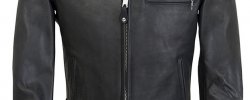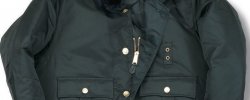Motorcycle Leather Jackets Waterproof
 You can buy safety – at least when it comes to motorcycle jackets. There is a very wide selection of models available, and it isn't always easy to find the right jacket for your individual needs. Besides personal taste, you'll need to pay attention to some general criteria. That's the only way you'll be able to enjoy your ride in comfort and safety.
You can buy safety – at least when it comes to motorcycle jackets. There is a very wide selection of models available, and it isn't always easy to find the right jacket for your individual needs. Besides personal taste, you'll need to pay attention to some general criteria. That's the only way you'll be able to enjoy your ride in comfort and safety.
The 10 Most Important Criteria For Buying a Motorcycle Jacket
It's easy to find and buy motorcycle jackets on eBay. If you don't carefully select this important piece of protective clothing, you might regret your purchase later. The following 10 point checklist is intended to help you invest in the right piece of clothing, so you can be guaranteed comfortable, carefree riding fun.
1. Choose a Jacket to Match Your Riding Style
The first decision you need to make is whether you really need a separate motorcycle jacket, or if it might be better to buy a one-piece motorcycle suit.
One-Piece Suits
A one piece suit is full body protection which fits close to your skin and won't flap in the wind while you're riding. If you like to race your bike or sail through traffic on the freeway on your sport bike, you might prefer purchasing a one-piece motorcycle suit.
Two-Piece Suits
The combination of a motorcycle jacket and pants is ideal for people who want flexibility. If you're just taking a casual ride, you won't have to take along both pieces of your outfit. You can simply pull off your jacket and replace it with an everyday coat when you get to your destination. Furthermore, motorcycle jackets offer more storage space than one-piece suits, and usually have enough pockets for your wallet and documents. If you want the most flexible option, you will do well to buy a separate motorcycle jacket
2. Choose Quality Material
Bikers argue over the basic question of whether a motorcycle jacket made of textile or one made of leather is a better choice. These materials differ greatly from one another, but they do have one thing in common: the performance of the jacket will depend greatly on the quality of the material and how it's manufactured. It takes a lot of experience to recognize this type of quality. That's why it's helpful for less experienced or entry-level riders to seek advice from more experienced riders.
Leather Motorcycle Jackets
Motorcycle jackets made of a high quality leather have good abrasion resistance and offer excellent protection from injury if you do get into an accident. If you choose a jacket made of goat leather or calfskin, you need a thickness of at least 1.2 to 1.4 millimeters. That's just a fraction of an inch, but if your leather is any thinner it will have only limited protective properties. Kangaroo leather is another interesting material; because of its sturdiness you can get away with a jacket just 1 to 1.1 millimeters thick.
Leather and Textile Motorcycle Jackets
More and more manufacturers are offering jackets made of a combination of leather and textile materials. Leather usually covers the most vulnerable parts of the body, including the upper back, shoulders, and bottoms and tops of the arm. The textile weave offers better comfort by creating extra ventilation.
Textile Motorcycle Jackets
Jackets made of a fabric like nylon includes many abrasion resistant varieties like Armacor, Kevlar, Dynatec and 500 to 2000 denier Cordura. These materials often offer excellent breathability, protection from the cold, and waterproofness.
Tips for Making Your Choice
Cruisers, weekend riders, and touring bikers usually choose motorcycle jackets made of a textile like nylon or polyester, since they generally offer the best comfort. Sportier riders place a little more emphasis on safety, especially if they take bigger risks in traffic or racing, and tend to choose sturdier leather jackets. Motorcycle jackets made of a combination of leather and textile are a sensible compromise.
3. A Motorcycle Jacket's Age is a Factor
When choosing a motorcycle jacket, you should note the model's age. Older jackets typically don't offer the same safety or comfort common in the industry today. This means the outer material as well as the protective padding might not give a rider enough protection from injury in case of an accident.
4. Look At the Jacket's Color
Most motorcycle riders have the same favorite color: black. In low light environments, however, a black motorcycle jacket can be very difficult to notice in traffic. That's why you should choose a jacket with an easy to recognize color. You can buy jackets in signal yellow or orange, or even ones that use large panels of reflective material. These will be visible when other drivers or riders shine their lights your way. This ensures good visibility and safety.
5. Find a Well-Made Motorcycle Jacket
Your motorcycle jacket needs to be well-constructed to ensure the best possible safety and comfort. That's why you should pay attention to the following points when making your purchase:
Seams
A motorcycle jacket's seams should always be inside the jacket, so they don't cause abrasion in case of an accident. Leather jackets should have very few seams, since more seams compromise the stability of the material. In addition, the chest and back should be made of a single piece of material and not of smaller pieces sewn together. This can have a negative effect on the jacket's safety.
Zippers
Zippers on motorcycle jackets can be made of plastic or metal. They need to be easy to open and quick to close. Furthermore, they should be covered with a flap of fabric so they don't pose extra risk of injury in a crash. Coverings over a zipper also offer extra, effective protection against moisture in textile jackets.
6. Safety Should be Paramount
When choosing a motorcycle jacket, you should always keep safety in the forefront of your mind. Because of its texture, leather is more dense than textile weaves. As soon as the leather is placed under mechanical strain it undergoes a process of load distribution by stretching slightly. This protects the material from ripping easily. Textile materials perform worse than motorcycle jackets made of leather in this respect. It's easier to tear the weave, causing unprotected areas of your skin to slide across the pavement. That's why you should be sure that motorcycle jackets made of a textile weave are reinforced with materials like leather or kevlar.
7. Protectors
Motorcycle jackets should have integrated protectors. These are pieces of protective padding typically on the arms, back, and chest of your jacket. Good jackets will indicate they are “CE approved, ” and there are both CE1 and CE2 levels of approval available for jackets. CE2 is a better level of protection.
Criteria for Choosing Protectors
Protective padding needs to be elastic and large enough to efficiently distribute the energy in a crash.
Close-fitting motorcycle jackets should have protectors attached to the outside of the jacket.
If the motorcycle jacket has a looser fit, the protectors should be larger and fit close to the part of the body they are intended to protect.
Protectors shouldn't restrict your comfort, but should cover a large enough surface area to protect your upper body.
Elbow protectors should always protect your ulna from injury.
8. Choose a Comfortable Jacket
A high quality motorcycle jacket doesn't just need to protect your body, it also needs to offer great comfort.
Weight and Storage Space
Leather motorcycle jackets are typically heavier than jackets made of a woven textile. They also have less pockets where you can store your money or possessions. Which characteristics will be most important to you depend primarily on your individual needs.





